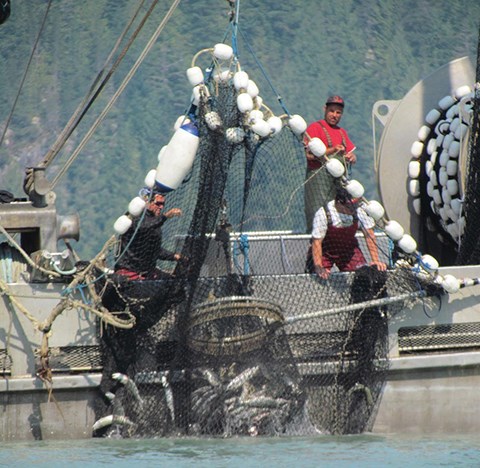For the second time in more than two decades there was commercial fishing of pink salmon in Howe Sound.
Despite opposition from the Squamish Nation, a marine expert and some local residents, Fisheries and Oceans Canada (DFO) opened the Sound to two seine fishing vessels and announced it would be open from August 10 to 15, between 6 a.m. and 9 p.m. daily.
It later closed the fishery early without public explanation on August 12.
Squamish Nation spokesperson Chris Lewis is not impressed commercial nets were scooping up fish in Howe Sound.
“The Squamish Nation rejects absolutely this proposed fishery,” Lewis wrote in a letter to the DFO prior to the fishery opening that was shared with The Squamish Chief. “We must protect these stocks.”
Lewis pointed out that Squamish watershed pink salmon have suffered from depleted stocks and overfishing.
“We are opposed to such a fishery in the light of the absence of a strong run that can sustain commercial harvesting,” Lewis said.
According to a DFO spokesperson, the fishery was opened based on information that showed a strong return of pink salmon to the Squamish River could be expected this year.
“Planning for this fishery was informed by small-scale exploratory commercial seine fishery conducted in 2013, as well as 2013 escapement and 2014 out-migrant information,” the spokesperson said in an email, adding that information from this fishery will support the future management of the pink salmon population.
Independent, on-board observers, according to the spokesperson, monitored this year’s Howe Sound opening. Any fish species other than pink salmon were to be released, and the fishery didn’t go against any existing closures in Howe Sound, including those around glass sponge reefs, according to the DFO.
Roy Mulder, president of the Marine Life Sanctuaries Society of BC, said his group’s main concerns were related more to threats posed by the fishery to the Rockfish Conservation Areas and sponge reef sites.
“As some of the key sponge reefs aren’t even on the DFO maps, let alone under protection, they remain vulnerable to a seine opening,” Mulder said. “Howe Sound is vulnerable at many levels, and each of these threats accumulate and undermine conservation efforts.”
News of this fishery was shared with First Nations and other interested parties, according to the DFO.
At least one local conservationist says the news was not shared widely enough.
“It caught everyone by surprise, I think,” said David Ellis, former head of the federal government’s Committee on the Status of Endangered Wildlife in Canada.
Ellis said he follows Squamish’s salmon runs carefully.
Ellis argues that Squamish communities have struggled for decades to bring the salmon back to the Squamish River, and the slow recovery process that has taken place is at risk because of this fishery.
He said the nitrogen that would arise from this returning run of pink salmon is needed to restore the health of the river.
“You need lots of dead fish [in the river] to get more fish to come back,” he said. The surplus of dead fish is hugely important to the ecosystem, according to Ellis.
“Just because the fish are there it doesn’t mean you should catch them.”
Squamish environmentalist and fisherman John Buchanan went out to visit the fishing vessels last week and says he spoke to the fishermen on board. He said unlike in 2013, this time there doesn’t seem to be the big pink salmon catch.
The crew of the Shani Lynne commercial fishing boat had set their nets near Watts Point and came up with only a small catch of salmon, Buchanan said.
“Quite different from the scene I witnessed during the 2013 fishery,” he said.
Buchanan said one of the two fishing vessels in 2013 had filled its hold to the halfway mark with about 25,000 pink salmon.
The DFO said Wednesday it closed this year’s fishery early because there were not as many fish as were anticipated. Interested parties will be notified before a reopening, an email from the DFO stated.
Prior to 2013, commercial fishing nets hadn’t been in the sound since 1962.



